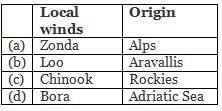Test: Geography- 10 - UPSC MCQ
25 Questions MCQ Test - Test: Geography- 10
Consider the following statements regarding Ocean Currents.
- Water density and temperature influences the mobility of ocean currents.
- Cold Water ocean currents travel from the equator along the surface, towards the cold polar regions.
- Labrador current is a cold current.
Which of the above statements is/are correct?
Consider the following statements.
- Surface current constitute more than the deep-water currents.
- Cold currents are usually found in the west coast in the higher latitudes in the Northern Hemisphere.
- Warm currents are found on the east coast of continents in the low and middle latitudes.
Which of the above statements is/are correct?
| 1 Crore+ students have signed up on EduRev. Have you? Download the App |
Consider the following statements:
- Garo and Khasi hills are extensions of Purvanchals in Meghalaya forming water divide between Brahmaputra and Barak River.
- Rajmahal Hills are formed from rocks dating from the Jurassic Period and named after the town of Rajmahal which lies to the east in the state of Jharkhand.
Which of the above statements is/are correct?
Tropic of Capricorn passes through which of the following countries?
- Argentina
- Bolivia
- Chile
- Botswana
- Mozambique
- Zimbabwe
- Australia
Select the correct answer code:
Which of the following are the examples of footloose industries?
- Mobile manufacturing
- Diamond processing
- Iron and Steel Industry
- Computer chips industries
- Cement industry
Select the correct answer code:
Which of the following activities belong to the Quaternary activities in an Economy?
- Production and dissemination of information
- Research and development
- Medical Tourism
Select the correct answer code:
Which of the following are ferrous minerals?
- Bauxite
- Iron Ore
- Copper
- Manganese
Select the correct answer code:
According to Mines and Minerals (Development and Regulation) Act, 1957, which of the following are declared as Minor Minerals?
- Chalk
- Lignite
- Brick-earth
- Marble
- Gravel
Select the correct answer code:
Which among the following best describes the term ‘Black Gold’?
Consider the following statements.
- S-waves produced by an earthquake can travel only through solid materials.
- ‘Shadow zone’ of an earthquake refers to the zone where the tendency of experiencing an earthquake is the maximum.
Which of the above statements is/are correct?
Earthquakes can occur at
- Divergent plate boundaries.
- Transform boundaries.
- Ocean-ocean convergent plate boundaries
- Ocean-continent plate boundaries.
Select the correct answer code:
Arrange the following regions in decreasing order based on the potential of Incidences of Landslides:
- Himalayas
- North-eastern Hills
- Vindhyachal
- Western Ghats and the Nilgiris
Select the correct answer code:
Brahmaputra River is often flooded in India, but not in Tibet. What can be the possible causes for it?
- In India it passes through a region of high rainfall, while Tibet is a dry cold area.
- Brahmaputra is marked by huge deposits of silt on its bed causing the river bed to rise.
Select the correct answer code:
Among the following, the crop that is least drought-resistant is
Practices that increase organic matter in the soil include
- Leaving crop residues in the field
- Frequent tillage
- Mulching
- Growing cover crops
Select the correct answer code:
Consider the following statements:
- The folds of the Great Himalayas are symmetrical in nature.
- The longitudinal valley lying between lesser Himalaya and the Shiwaliks are known as Duns.
Which of the above statements is/are incorrect?
Consider the following statements regarding Red and yellow soils.
- They can develop on crystalline igneous rocks.
- They are found only in regions of highest rainfall and highest temperature in India.
- They look yellow when it occurs in a hydrated form.
Which of the above statements is/are correct?
Consider the following statements regarding Alluvial soils.
- Alluvial soils are suitable for the growth of sugarcane, paddy and pulse crops.
- Alluvial soils contain adequate proportion of potash, phosphoric acid and lime.
Which of the above statements is/are incorrect?
Mangrove forests can be found in which of the following river deltas?
- Cauvery
- Krishna
- Mahanadi
- Godavari
Select the correct answer code:
Which of the following factors Influence the formation of South-West Monsoon?
- Shift of the position of Inter Tropical Convergence Zone (ITCZ)in summer.
- Presence of the high-pressure area,east of Madagascar, approximately at 20°S over the Indian Ocean.
- Movement of the westerly jet stream to the north of the Himalayas and the presence of the tropical easterly jet stream over the Indian peninsula during summer.
Select the correct answer code:
Winter rainfall in Punjab, Haryana, Delhi and western Uttar Pradesh occurs mainly due to
- Northeast monsoon crossing over the Bay of Bengal
- Anti-cyclonic circulation patterns in Northern India in winter
- Arrival of weak temperate cyclones from the Mediterranean Sea
Select the correct answer code:
Consider the following statements regarding ‘Savanna Climate’.
- It is characterised by an alternate hot, rainy season and cool, dry season.
- Majority of the areas have lateritic soils which support good crops.
- The Hausa tribes are found here.
Which of the above statements is/are correct?
Which of these seasons provide the most favourable conditions for the redistribution of water and oxygen in lakes that are vital for the growth of organisms such as phytoplankton?
If the elliptical orbit of earth around the Sun changes to a circular orbit, which one among the following may result in that situation?


















